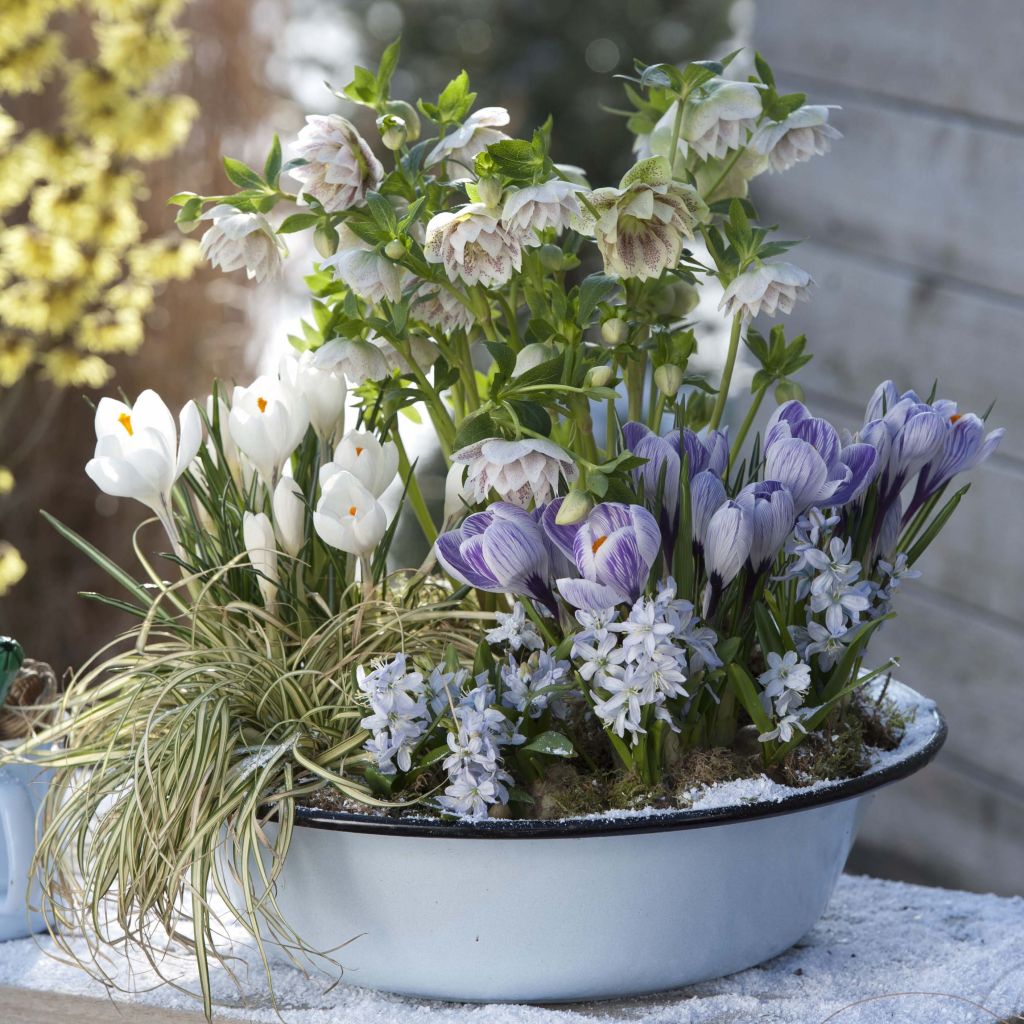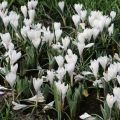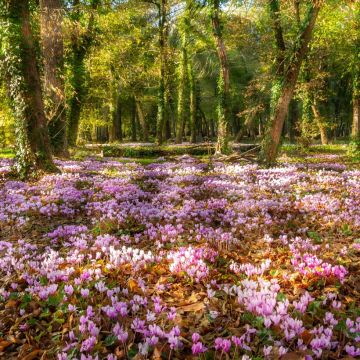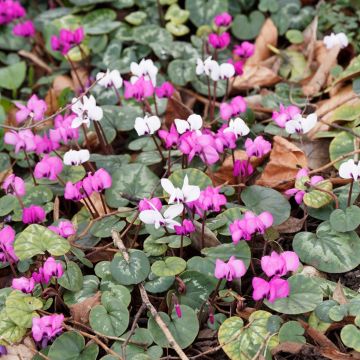

Pot collection of bulbs and Hellebore
Pot collection of bulbs and Hellebore
Young plants and bulbs arrived in good condition. I am waiting for the flowering.
Yolande, 28/10/2022
Special offer!
Receive a €20 voucher for any order over €90 (excluding delivery costs, credit notes, and plastic-free options)!
1- Add your favorite plants to your cart.
2- Once you have reached €90, confirm your order (you can even choose the delivery date!).
3- As soon as your order is shipped, you will receive an email containing your voucher code, valid for 3 months (90 days).
Your voucher is unique and can only be used once, for any order with a minimum value of €20, excluding delivery costs.
Can be combined with other current offers, non-divisible and non-refundable.
This plant carries a 6 months recovery warranty
More information
We guarantee the quality of our plants for a full growing cycle, and will replace at our expense any plant that fails to recover under normal climatic and planting conditions.

Would this plant suit my garden?
Set up your Plantfit profile →
Collection items (77 plants)
Description
A collection to compose a delightful potted or flowering planter that will brighten balconies or terraces from the heart of winter until the arrival of spring. The white flowers of the 'Double Blanc' Hellebore will appear as early as January; they will soon be joined by the beautiful blue shades of crocuses and Puschkinia, which will extend the spectacle until the end of March. The foliage of the carex and hellebore will remain decorative all year round. This very hardy collection will be ideal to brighten up a semi-shaded terrace, on a balcony or in front of the entrance door. These woodland plants should be protected from the burning rays of the sun in summer.
This collection consists of:
- 1x Double Blanc guttatus Oriental Hellebore: a bushy perennial plant, 40cm (16in) tall and 30cm (12in) wide. Double white flowers with purple dots from January to March. Basal palmate evergreen leaves, slightly dentate, dark green and shiny.
- 1x Evergold Oshima Sedge: an evergreen grass forming a dense clump with beautiful trailing green leaves highlighted by a wide creamy yellow stripe. Its evergreen foliage is decorative both in summer and winter. Its flowers are reduced to small upright spikes of light brown colour. Height and spread of about 30cm (12in).
- 25x Jeanne d'Arc Mammoth Crocus: an old variety with large pure white flowers illuminated by orange stamens. Particularly bright and easy to grow. Flowering in February-March. Height of flowers is about 10cm (4in).
- 25x Pickwick Mammoth Crocus: an old variety with large white flowers veined and striped with mauve and bluish-violet, particularly radiant and easy to grow. Flowering in February-March. Height of flowers is about 10cm (4in).
- 25x Libanotica Scilla-like Puschkinia: a beautiful bulbous woodland plant with clusters of pale blue bell-shaped flowers streaked with turquoise in early spring. Its glossy ribbon-like leaves form beautiful upright tufts.
Report an error about the product description
Plant habit
Flowering
Foliage
Other Spring bulb collection
View all →Planting and care
Create your display of plants from September to December, in rich and light soil. First, plant the perennials, making sure to place the tallest plants at the back, then insert the bulbs between the perennials at a depth of 5cm (2in) and a spacing of about 5cm (2in). Cover with soil. For perfect finishing touches, if there are any areas where the soil is visible, cover it with a little moss collected from the garden. Water well during planting. Afterwards, the composition should be able to rely on autumn rain. If they are not sufficient, water, but make sure to let the soil dry between waterings: these plants do not like stagnant water, which can cause them to rot.
Planting period
Intended location
Care
-
, onOrder confirmed
Reply from on Promesse de fleurs
Haven't found what you were looking for?
Hardiness is the lowest winter temperature a plant can endure without suffering serious damage or even dying. However, hardiness is affected by location (a sheltered area, such as a patio), protection (winter cover) and soil type (hardiness is improved by well-drained soil).

Photo Sharing Terms & Conditions
In order to encourage gardeners to interact and share their experiences, Promesse de fleurs offers various media enabling content to be uploaded onto its Site - in particular via the ‘Photo sharing’ module.
The User agrees to refrain from:
- Posting any content that is illegal, prejudicial, insulting, racist, inciteful to hatred, revisionist, contrary to public decency, that infringes on privacy or on the privacy rights of third parties, in particular the publicity rights of persons and goods, intellectual property rights, or the right to privacy.
- Submitting content on behalf of a third party;
- Impersonate the identity of a third party and/or publish any personal information about a third party;
In general, the User undertakes to refrain from any unethical behaviour.
All Content (in particular text, comments, files, images, photos, videos, creative works, etc.), which may be subject to property or intellectual property rights, image or other private rights, shall remain the property of the User, subject to the limited rights granted by the terms of the licence granted by Promesse de fleurs as stated below. Users are at liberty to publish or not to publish such Content on the Site, notably via the ‘Photo Sharing’ facility, and accept that this Content shall be made public and freely accessible, notably on the Internet.
Users further acknowledge, undertake to have ,and guarantee that they hold all necessary rights and permissions to publish such material on the Site, in particular with regard to the legislation in force pertaining to any privacy, property, intellectual property, image, or contractual rights, or rights of any other nature. By publishing such Content on the Site, Users acknowledge accepting full liability as publishers of the Content within the meaning of the law, and grant Promesse de fleurs, free of charge, an inclusive, worldwide licence for the said Content for the entire duration of its publication, including all reproduction, representation, up/downloading, displaying, performing, transmission, and storage rights.
Users also grant permission for their name to be linked to the Content and accept that this link may not always be made available.
By engaging in posting material, Users consent to their Content becoming automatically accessible on the Internet, in particular on other sites and/or blogs and/or web pages of the Promesse de fleurs site, including in particular social pages and the Promesse de fleurs catalogue.
Users may secure the removal of entrusted content free of charge by issuing a simple request via our contact form.
The flowering period indicated on our website applies to countries and regions located in USDA zone 8 (France, the United Kingdom, Ireland, the Netherlands, etc.)
It will vary according to where you live:
- In zones 9 to 10 (Italy, Spain, Greece, etc.), flowering will occur about 2 to 4 weeks earlier.
- In zones 6 to 7 (Germany, Poland, Slovenia, and lower mountainous regions), flowering will be delayed by 2 to 3 weeks.
- In zone 5 (Central Europe, Scandinavia), blooming will be delayed by 3 to 5 weeks.
In temperate climates, pruning of spring-flowering shrubs (forsythia, spireas, etc.) should be done just after flowering.
Pruning of summer-flowering shrubs (Indian Lilac, Perovskia, etc.) can be done in winter or spring.
In cold regions as well as with frost-sensitive plants, avoid pruning too early when severe frosts may still occur.
The planting period indicated on our website applies to countries and regions located in USDA zone 8 (France, United Kingdom, Ireland, Netherlands).
It will vary according to where you live:
- In Mediterranean zones (Marseille, Madrid, Milan, etc.), autumn and winter are the best planting periods.
- In continental zones (Strasbourg, Munich, Vienna, etc.), delay planting by 2 to 3 weeks in spring and bring it forward by 2 to 4 weeks in autumn.
- In mountainous regions (the Alps, Pyrenees, Carpathians, etc.), it is best to plant in late spring (May-June) or late summer (August-September).
The harvesting period indicated on our website applies to countries and regions in USDA zone 8 (France, England, Ireland, the Netherlands).
In colder areas (Scandinavia, Poland, Austria...) fruit and vegetable harvests are likely to be delayed by 3-4 weeks.
In warmer areas (Italy, Spain, Greece, etc.), harvesting will probably take place earlier, depending on weather conditions.
The sowing periods indicated on our website apply to countries and regions within USDA Zone 8 (France, UK, Ireland, Netherlands).
In colder areas (Scandinavia, Poland, Austria...), delay any outdoor sowing by 3-4 weeks, or sow under glass.
In warmer climes (Italy, Spain, Greece, etc.), bring outdoor sowing forward by a few weeks.







































